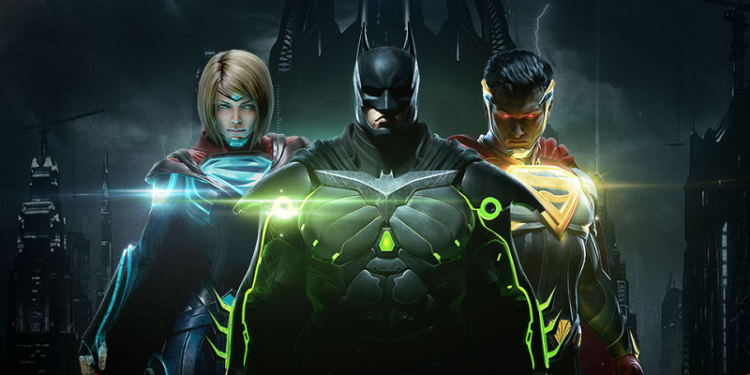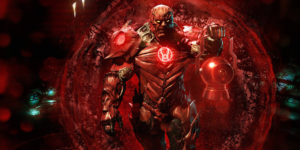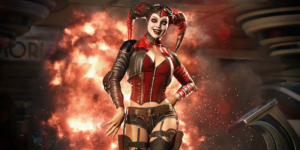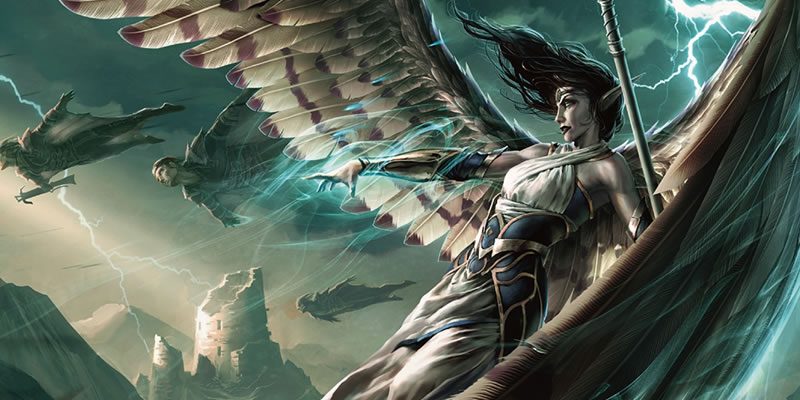Injustice 2 and the RPGification of Other Genres

You have to go back quite a while to find the last fighting game I played to any level of seriousness. It was twenty years ago when I first played Tekken 3 in the arcades, and nineteen years since I played it seriously on the Playstation 1. Until then, I played a lot of different fighting games – my favorite “big series” title was Killer Instinct, while my favorite smaller ones were Bushido Blade and Wu-Tang: Shaolin Style. As I have written about here before, I even played the Ravenloft D&D fighting game at length. It wasn’t until Tekken 3 that I experienced my friends becoming so frustrated with playing against me they wouldn’t play unless I promised not to pick certain characters. That quickly devolved into not wanting to play against me at all, and it carried over into the Marvel vs. Capcom and Soul Caliber series. After that, they just stopped wanting to play them entirely. In those days, there wasn’t much reason to play fighting games without other people around – online play wasn’t a thing – and I didn’t have the money necessary to continually go to arcades and play. So, I stopped playing and never really looked back save for group fighting games like Super Smash Bros. and their ilk. This was true for nearly two decades, until I picked up Injustice 2. So what made me – someone who doesn’t really care about comics one way or the other – pick up Injustice 2? The fact it was an RPG that happened to also be a fighting game.
For the most part, the story of fighting games has been…simple, to put it kindly. While there are certainly exceptions, the story has always cleaved close to the most basic reason for dudes (dudes applying to all genders equally) to be fighting – a martial arts tournament. Sometimes this is an evil tournament set up by demon lords or sorcerers, and sometimes it’s just to prove that you are some sort of royalty of combatants – a king of fighters, if you would. When you play through single player, there is usually some sort of lore that ties several of the characters together – someone is an evil sibling that’s been brainwashed, someone is a criminal and you’re a futuristic space cop that knows kung fu, you’re actually a ghost inside of a bear, whatever. There is usually a story cinematic or scrolling story text that you get once you’ve beat the game, and each character gets one. For a long time, that’s just how fighting games were.

Tell Me a Story
Injustice 2 is a DC superhero fighting game by NetherRealm Studios – the same company behind Mortal Kombat. It uses a very similar engine to Mortal Kombat – even taking on and altering some of the same secondary systems. The conceit is Superman had a mental break after Lois Lane was killed by the Joker – who decided Batman was no fun any more. Superman decides that the only way forward is to take charge of the entire world, and establish a new government for all – named the Regime. There is also some super serum that allows people to become hella strong, and thus allows for heroes and villains to not be obliterated when Superman punches them – allowing for a fighting game at all. Batman leads the rebellion against Superman, and helps to defeat him in the first Injustice game. Injustice 2 sees Brainiac – who is some sort of Doctor Manhattan meets Doctor Octopus in this game – coming to earth and collect all of its knowledge and destroy it. There are a lot of twists and turns along the way. Injustice 2’s story mode has between 10-15 hours of content, all told.
Having a lot of content doesn’t necessarily make something an RPG – though I might argue that it often shakes out that way in this day and age, as lines become more and more blurred. Still, you might be hard-pressed to find someone who disagrees that choose-your-own-adventure games and stories aren’t at least light RPGs. Despite the mechanical underpinnings of a fighting game, that’s really what the single player experience of Injustice 2 is all about. As you progress through the story, you are presented with opportunities to choose one set of combatants over the other. When you do so, you experience that segment of the story – separated into chapters – from the perspective of those characters. The other characters go off to do a thing, and you need to replay through the chapter in order to experience the other branch of the tale. This even included the canonical ending to the game. You either end up siding with Batman or Superman, and the ending for the game spirals out from that initial final chapter decision. If there is a third game in the series, we will probably know which ending is the canonical one – though it would be rad if they went the Quest for Glory route and let you port over your data from one game to the next to determine world/story continuation. Sure, I could have said Mass Effect or Dragon Age, but Quest for Glory is an all-timer of a series. Deal with it.
While this is awesome to a lot of people, some might worry that the old standby of getting a small character vignettes you receive when you beat the game with a character might be missing – since you only play through choose your own adventures. Never fear, old stalwarts – there is a gameplay option that gives you just that. You simply pick a character and fight a bunch of dudes in a row – no frills. You play through as individual characters, and are rewarded with a motion comic at the end that depicts the personal motivations and conflicts of the characters, and what their resolution looks like. This exactly the old model for fighting games, so it’s inclusion is a nice continuation of what came before – but it’s not the primary experience. In fact, this model exists within the “end game” framework for the game – the Multiverse.

Countless Worlds, At Your Fingertips
If you are familiar with comics, you are familiar with the Multiverse. If you are not familiar with comics, the Multiverse is a way to explore alternate versions of characters and storylines without worrying about continuity, longevity, or any sort of lasting impression. What if Batman was scared of octopi instead of bats? What if Swamp Thing became a hipster business tycoon? What if Wonder Woman went pro at disk golf and it took off as a national sport? These are all things that might make for a good one-off comic, but wouldn’t be great for a serialized run. The same thing is true in Injustice 2. The Multiverse offers sidekicks (characters in the game) and allies (characters not in the game) to assist you as you combat characters in alternate timelines and worlds. Some of the worlds are just “Cyborg has become Grid, deal with it,” others are “gravity reverses constantly, so you have to fight upside down for a few seconds and it reverses your inputs,” and still others are “each stage shoots off fireworks that you need to avoid, and there are progressively more and varied fireworks as you go through your fights.” The multiverse also offers “boss” versions of characters to fight – much more difficult versions of the characters with different movesets and skills not normally available to them (Boss Brainiac fires off mechanical graboids, for instance). The multiverse refreshes every few hours offering new planets and new experiences. Not only is it a very fun way to practice and get better at characters, this is also where another RPG aspect of the game lies – the leveling and gearing process.
Levels and gear? In a fighting game? Absolutely, and it’s done in a smart way. When you play against other players locally, you can choose to enable or disable variable levels and gear. If choose to disable this, characters are set at level 20 with their max stats and everyone can just duke it out. If you play against others online, it defaults to this mode. The gearing and leveling grind is there for the multiverse, guild multiverse – multiverses that require multiple people to defeat, and legendary multiverse – if you are cray-cray and have mastered Batman or others until you are more machine than man – experiences. AI difficulty varies from a joke to perfect performance, and choosing the right gear for the situation can matter tremendously. Instead of being an actual grind, basically everything you do in the multiverse rewards you with loot boxes that are set when you receive them. The loot boxes contain random gear inside of them, and you can also attain currency to re-roll any piece of gear to become the same base type of gear at your current level. This matters because there are gear sets within the game – because of course there are. It’s really not a slog, and gearing up is actually a pretty fun process. Everything you do helps you in some way.
Injustice 2 also makes the smart choice to link up their multiverse content with the release of other DC media. There was an event for you to get a gear set for Wonder Woman that looked like her outfit from the latest movie. There is a method to make any piece of gear look like another piece of gear, of course. There are events for new seasons of the DC television shows, announcements of other games, etc. It’s full on integration that costs nothing and shows a willingness to allow other stories and mediums to be experienced within its framework. It’s minor, but it’s a comic book game. This sort of cross-promotion and branding is crucial to the full comic experience and has been going on for decades. It really gives you that sense of comic immersion.

Beyond Fighting Games
What’s really interesting is this isn’t the first time a different genre has decided to pick up elements of RPGs in order to retain and create a better experience for its player base. Borderlands took elements from action roleplaying games (ARPGs) to create a fantastic shooter series that continually advanced how stories were told in games. It completely revamped how quests are received and handed out in these games, while also presenting the best villain I have seen in a game in years. Another in the series shook things up again by framing the game as a flashback from the perspective of one of the characters. The character relays this story to other characters – providing the tone of the game from the character interactions. The first playthrough of the game is fairly serious, as all involved are serious people. The second playthrough has the character re-telling the story to two comical characters, completely changing the tone of the game even though the actions and content are the same. It was absolutely brilliant.
Destiny and Destiny 2 took this sort of model for a game and ran with it, applying it to the Halo style of shooter. This exposed another group of players to RPGs without them truly realizing it was an RPG. WWE2k# game series does the same thing. You create a wrestler, give them a persona, skills, and begin to train them up and advance them through the different brands. You involve yourself in storylines, feuds, and even decide to purposefully try and game the audience in order to become more and more popular. It’s probably the first time I’ve seen this sort of meta-textual presentation of games, players, and scripted media done so well. This is to say nothing of the boom of fantasy sports leagues – including the Football Manager series where you just manage a football/soccer team online as part of a video game and that’s it.
While this article isn’t really touching upon tabletop or advice, things like this are crucial to the ongoing acceptance and wider success of the genre. While it’s certainly easy to draw comparisons between fantasy football and D&D, it’s just as easy to illustrate the differences. The players are real people, it’s a competition instead of a collaboration, there isn’t any of that “nerdy story shit” in it, etc. These are all things I have personally heard. However, I have watched the progression of people go from ARPG -> MMORPG -> Tabletop RPG, and I have seen people now go FPS -> ARPGFPS -> MMORPGFPS -> Tabletop RPG. The key is people realizing they enjoy the story elements of the game, and being able to be granted the agency to take on some of the iconic aspects of the characters they enjoy without the restrictions present in many of the games. You want to explore what it would be like to be an employee of the Torgue Corporation? No problem, tabletop games are here for you.
The Rub
We should always be on the lookout for story being embraced in other gaming mediums. As story evolves, more and more people are exposed to what we already love. Think of all the people that were so invested in Mass Effect or Dragon Age and still talk about the characters and elements they identified with. Dragon Age has a published tabletop system and setting. How easy would it be to transition players of the video game series to a tabletop game? Very easy, in many cases.
It’s not even about getting them to play the tabletop game, though. It’s more about showing other people what we love about what we do. The RPGification of different genres allows us to do just that.



